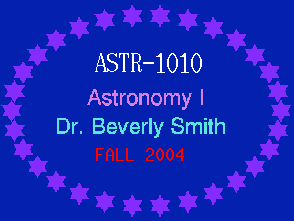

See the answer on the
NASA Goddard Space Flight Center
`Imagine the Universe!' web page.
As we demonstrated in class, when a metal ball and a wad of paper
are dropped, they fall at the same rate. The acceleration
of a falling object is independent of its mass. The reason this
happens is that the gravitational force is:
F = G M(object) M(planet) / R2
The acceleration of the object A(object) is determined by:
F = M(object) A(object)
Setting the equations for F equal gives:
G M(object) M(planet) / R2 = M(object) A(object)
Since M(object) is on both sides of the equation, it can
be eliminated, so
G M(planet)/ R2 = A(object)
And the acceleration of the object doesn't depend upon
its own mass, just on the mass of the planet.
This means that if the mass of the planet changes, the
acceleration of the object changes, but if the mass
of the object itself changes, its own acceleration doesn't
change.
When calculating the gravitational force on the surface
of a planet, remember that for a spherical object, the
gravitational force is measured from the center of planet,
that is, the R in F = G M(object) M(planet)/ R2 is measured
from the center of the planet.
a) To find which object is highest in the sky
at a certain date and time, set your Star and Planet
Locator to that time and date. Then look for the
constellations along the meridian (the line that runs
from North to South on the S+P locator).
b) If you would like to know the celestial
coordinates (R.A. and Dec.) of a constellation,
look at the
Peoria Astronomical Society constellation web page.
On the statements involving time:
Remember Kepler's second law, and that
it means planets slow down when further
from the Sun. Look carefully at the
picture, and assume the picture is drawn
correctly to scale (i.e., distances that
are longer in the drawing really
are longer in space).
For the statement involving the period,
use Kepler's Third Law P2 = a3.
Consider two planets x and y, with semi-major
axes of their orbits of ax = 2ay.
Write down the equation twice, once for each
planet:
Problem 9 is a comparison problem, where one compares two objects.
For this kind of problem, a comparison of
two different objects, the easiest way to
solve the problem is to start by writing down the
relevant equation twice, once for each object.
For this particular problem, the equation in question is
the relationship between theta, the angular size, x, the physical
size, and D, the distance:
theta(A) prop. to x(A)/D(A)
theta(B) prop. to x(B)/D(B)
Then divide the two equations. When you
divide two proportionalities, you can replace
the prop. to signs with equal signs. So then
you get:
theta(A)/theta(B) = (x(A)/D(A))/(x(B)/D(B))
Then simplify. In this case, flip over the fraction in the denominator,
and multiply instead of divide:
theta(A)/theta(B) = (x(A)/D(A)) * (D(B)/x(B))
and simplify further:
theta(A)/theta(B) = x(A)*D(B) / (D(A)*x(B))
Plug in the known values and solve for the unknown.
The easiest way to solve these problems is to draw pictures
of the Sun, Moon, and Earth, and a person on the Earth.
The trick is
to remember that people are really tiny compared
to the Earth, so can't see over their horizon
(a line tangent to the Earth where they are located),
and that the Sun and Moon are *really* far away from the
Earth, compared to the size of the Earth--essentially
at infinity (so parallel
lines intersect at the Sun or Moon). Also, remember
that sunset (i.e., about 6 PM) occurs when the location of
the viewer is turning away from the Sun, and the Sun is
on the observer's horizon.
This is easiest to explain with a picture:
s o- m
Imagine the "o" is the Earth, the "s" is the Sun, the "m"
is the Moon, and the "-" is a person
on the Earth. The person is on the opposite side of
the Earth from the Sun, so it is midnight
for the person.
The Moon is also opposite the Sun, so it is a full moon.
The Moon is directly above the person, so the Moon is
on the meridian for that person at midnight.
Here's another drawing:
|
This is still the full moon.
Looking down on the north pole, the Earth is spinning counterclockwise.
For this person, the Sun is on the eastern horizon (i.e., the person
is turning towards the Sun, that is, the Sun is rising). (remember,
the person can't see past his/her horizon, which is tangent to
its location on the Earth, and parallel lines intersect at infinity).
Here's the same drawing with the horizon marked, as well as parallel
lines going to the Sun and Moon:
The Sun is on the horizon for the observer, and the person is
turning towards the Sun, so it is 6 AM for this person.
The person is turning away from the moon, and the moon
is on the horizon. This means the moon is setting. So a full moon
sets at 6 AM.
Here's another drawing:
m
In this case, we see half the face of the Moon (i.e., its a quarter
Moon).
Looking down on the North Pole, not only is the Earth spinning
counterclockwise, but the Moon is orbiting the Earth counterclockwise.
So the Moon is getting closer to the Sun. So its a waning Moon,
or 3rd quarter.
Like in the last picture, it is 6 AM for the person, so at 6 AM
a 3rd quarter Moon is directly above the person.
Here's another picture:
m
Again, it is 3rd quarter, but now the person is on the side
of the Earth facing the Sun, that is, it is noon. The Earth is
spinning counterclockwise, so the person is moving away
from the Moon. The moon is on the horizon for that person,
i.e., it is setting. So a third quarter moon sets at noon.
Px2 = ay3
Py2 = ay3
Divide the two equations, and solve for Px
in terms of Py. Then look at your answer to
tell whether Py < 1/2 Px or
Py > 1/2 Px
or Py = 1/2 PX.
s o m
horizon-----|-------------
s -----------o------------- m
|
s o
s -o













Students are NOT permitted to attend
a different lab section. If you miss a lab, you can make it up
in one of three different ways: 1) do one of the take-home labs,
2) attend the 11th meeting of your regularly-scheduled lab period.
Since only 10 labs are required for full credit, the 11th lab can be
used as a make-up or as extra credit,
3) attend one of the special day-time make up labs scheduled
at the Observatory at the end of the semester.
NOTE THAT THE MAXIMUM NUMBER OF LABS A STUDENT
CAN DO DURING THE SEMESTER IS 12; if a student has attended
all 11 regular evening labs and done a take-home lab, they
cannot also do the special day-time make-up lab.
Before the final exam, I will email everyone the grade they
will get in the course
IF THEY DO NOT TAKE THE FINAL.
Note that if you have missed a quiz, a zero will be averaged into
your pre-final grade, thus your pre-final grade does not
necessarily represent the grade you will get in the class
if you take the exam.
Remember that the final exam is worth two quizzes. The grade on
the final can be used to replace your two lowest quiz grades,
or can be used as a make-up if you have missed 1 or 2 quizzes.
If you have taken all 6 quizzes, you do not have to take the
final unless you want to improve your grade. If you do not
have an A in the course before the final, I strongly advise you
to take the final. Taking the final cannot hurt your grade;
it can just help. If you have a pre-final grade of a C and do worse on
the final than your two lowest quizzes, your course grade will be a C.
If you have changed your email address since
the beginning of the semester, please email your new email address
to me at  before the end of the semester so you will get your pre-final grade.
before the end of the semester so you will get your pre-final grade.